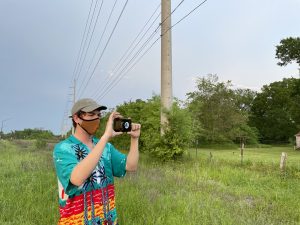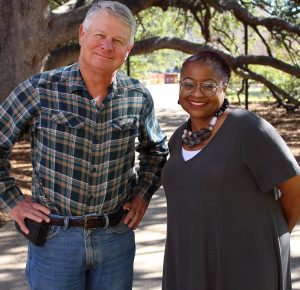Unique opportunities, customized paths attract students to communication degrees
As decision week for accepted freshman and prospective graduate students approaches, undergraduate and graduate students and faculty weighed in on the advantages of choosing COMM degrees at Texas A&M.
By Allison Brock

Natalie Parks, Class of ‘22 and COMM major, is Texas A&M Student Body President-elect for Fall 2021.
As decision week for accepted freshman and prospective graduate students approaches, Department of Communication faculty and undergraduate and graduate students weighed in on the advantages of choosing Texas A&M for higher education.
By allowing students to customize their education from a wide range of degree programs, students are able to create an education plan that suits their interests, goals, personalities and passions. From advising to faculty and student organizations, the COMM department offers an abundance of programs and opportunities for prospective students that continue to provide support to students from acceptance all the way through graduation.
Texas A&M is home for many scholars in the field of communication focused in areas of communication arts, humanities, sciences and practices to nurture students learning in rhetorical and critical thinking skills that are demanded by the profession today. From multimedia journalism to a strong foundation for advanced degrees, classroom-taught skills can be translated to a wide range of professions that allow students to critically examine information and effectively communicate with others, said Hart Blanton, head of the Department of Communication.
“There’s never been a more important time to have the combination of communication science and literacy,” said Blanton. “An understanding of how to apply these skills to the massive amounts of information, misinformation and disinformation that we’re all now bombarded with are the critical skills that we are teaching here.”
Ensuring academic success

Hannah Falcon, Class of ’21 and TCMS major, is a political reporting intern for @KXANN_News in Austin.
Students pursuing a degree in the COMM department are set up for success from the moment they accept an admissions offer, said Dr. Kristy Kulhanek-Stockmoe, lead academic advisor for the COMM department.
“We reach out to our freshmen students before they attend their New Student Conference,” said Kulhanek-Stockmoe. “There we give them a complete overview of our department, all of the different opportunities that they have, all the majors and minors they can choose from and the certificates offered by the department.”
Academic advisors attend entry level courses where they discuss the specific requirements of the degrees and talk about registration. Students are also required to attend degree checkup meetings to ensure they’re on track and to learn about high impact practices like study abroad, internships, student organizations, marketable skills and undergraduate research.
The COMM department also offers team advising, which is a practice unique to the department, said Dr. Kulhanek-Stockmoe.
“Every time we interact with a student, we take notes that are put in our system,” said Dr. Kulhanek-Stockmoe. “The next adviser that meets with that student can see what was discussed and pick up where the student left off.”
The deadline for undergraduate students to accept admissions offers for Fall 2021 is May 1.
Students can broaden the scope of their education by pursuing a graduate degree in the COMM department in two ways. The Ph.D. program is a research degree designed for students who want to become experts at conducting research and teaching at the university level. The master’s program follows two paths: one that has a thesis option for students who might later decide to pursue a Ph.D. by testing out the research experience; and a second non-thesis option geared toward developing portfolio pieces that help students in the job industry, explained Dr. Anna Wolfe, associate head of graduate admissions.
“This is a way to stay in Aggieland a little bit longer,” said Dr. Wolfe “Students can develop a little bit more of an expertise in communication and have some more time to develop some portfolio pieces that would hopefully make them more marketable for a number of careers that could use communication professionals.”
The deadline for students to accept graduate admissions offers for Fall 2021 is April 15.
Straight from the source of undergraduate students
 Madison Brown, a communication major with a journalism minor, just made the second big step in her career and credits faculty who have deep industry background to share with students for providing her the tools and direction necessary to launch her career. Hired as a communication specialist in the Texas A&M TurboMachinery Symposium office when she graduated in 2019, Brown said she just accepted a “dream job” as a marketing and communication associate for Bradley Construction Management in Dallas.
Madison Brown, a communication major with a journalism minor, just made the second big step in her career and credits faculty who have deep industry background to share with students for providing her the tools and direction necessary to launch her career. Hired as a communication specialist in the Texas A&M TurboMachinery Symposium office when she graduated in 2019, Brown said she just accepted a “dream job” as a marketing and communication associate for Bradley Construction Management in Dallas.
“The transfer of information from professor to student is 10,000 times better in the COMM department,” said Brown. Even with 1,500 undergraduates enrolled in communication degrees, students often create lasting mentor relationships with professors.

Mitchell Beddingfield, Class of ‘21 and journalism major, shoots video for Mobile Journalism in the aftermath of Hurricane Laura.
“It’s smaller and you can easily discuss questions with your professor and other students because it’s a close-knit group.” She credits the high-caliber education facilitated by professors like Angelique Gammon, Tom Burton and Dale Rice who have worked in the media industry for 30-plus years for helping her find a career path.
Communication (BA and BS), journalism studies (BA) and telecommunication media (BA and BS) studies are the five undergraduate degrees offered by the COMM department. Each offers a unique experience for students to pursue a wide range of post-graduate careers.
As a journalism studies major with minors in film studies and climate change, Mitchell Beddingfield said pursuing his dream as a future documentarian was more accessible at Texas A&M because of the ability students have to adjust their curriculum to fit their needs.
“I love this program because of its size and flexibility,” said Beddingfield. “It’s designed to instruct students in the best journalism practices and ethics and then let them decide where they want to take that.”
Texas A&M Student Body President-elect and junior class president Natalie Parks said the creativity and flexibility of the program is why she chose Texas A&M as the place to pursue a communication degree.
“I want to go into public relations, social media marketing and management,” said Parks. “There’s a social media certificate that people can pursue. I always thought that was a super-cool angle for focusing on the smaller piece of the big picture.”
Pursuing a degree in telecommunication media studies, senior Hannah Falcon has found the Texas A&M program valuable for students seeking a more personal classroom setting.
“The COMM department is really intimate, and you really get to know your peers and professors,” said Falcon. “You get the big school feeling with lots of clubs and opportunities, but you also get classes that you get to know your professors on a personal level.”
Grad students have a voice

Felicia York’s graduate research on communication strategies for traditionally marginalized populations prompted Dr. Richard Street to ask York to take the lead on the recent Grimes County Photovoice Project.
Her experience researching health communication can be summed up in three words – supportive, encouraging and prolific – said Felicia York, current COMM graduate student and doctoral candidate.
“Graduate students are financially, mentally and academically supported,” said York. “Students are encouraged to research, teach and publish; and are guided by prolific faculty who are not just talking the talk but walking the walk with their productive research publications, awards and authored books.”
Kelly Jo Eblen is a first year Ph.D. student conducting research in the area of organizational communication. Eblen said the COMM department’s program provides constructive motivation that allows research that will create positive change.
“This department is exceedingly special and even as I navigate being a part-time student and full-time employee, I’ve so gratefully gained a community of friends and a wholesome support system in fellow graduates who encourage me in solidarity, and faculty who dedicatedly nurture my growth in the program,” said Eblen.
Interdisciplinary learning that fosters critical engagement is what graduate student Marianna Rodriguez said she was seeking in a program. The Ph.D. program not only meets these requirements but also provides opportunities for growth in the field, Rodriguez said. She conducts research in the area of organizational communication and media, culture and identity.
“The faculty make great effort to align their curriculum to my research interest, prioritizing my learning,” said Rodriguez. “They advocate on my behalf when necessary and encourage me to be inquisitive. I am surrounded by students who instill confidence within me, champion for my mental health, and celebrate my victories.
“Today, I know that my decision to choose Texas A&M was the right one,” said Rodriguez.
Editor’s note: Allison Brock, Class of ‘21, is a journalism studies major with a business and history minor and is the 2020-21 news intern for the Department of Communication.
More about Undergraduate Degrees
